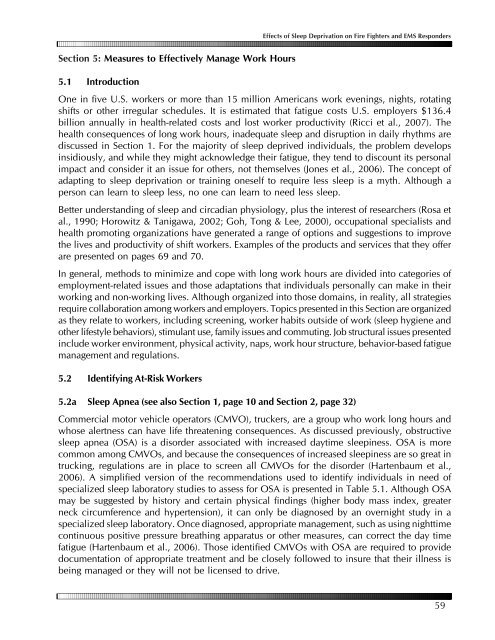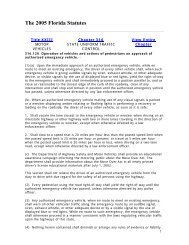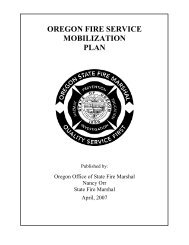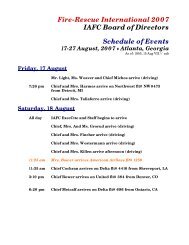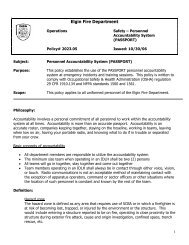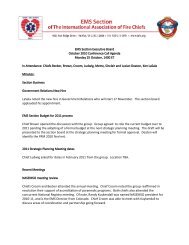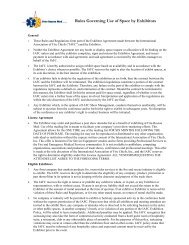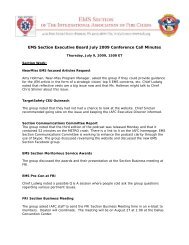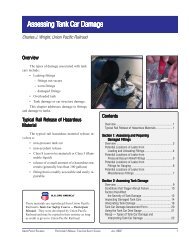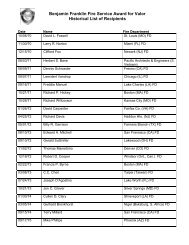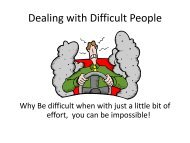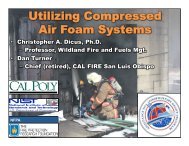Effects of Sleep Deprivation on Fire Fighters and EMS ... - NAEMT
Effects of Sleep Deprivation on Fire Fighters and EMS ... - NAEMT
Effects of Sleep Deprivation on Fire Fighters and EMS ... - NAEMT
Create successful ePaper yourself
Turn your PDF publications into a flip-book with our unique Google optimized e-Paper software.
<str<strong>on</strong>g>Effects</str<strong>on</strong>g> <str<strong>on</strong>g>of</str<strong>on</strong>g> <str<strong>on</strong>g>Sleep</str<strong>on</strong>g> <str<strong>on</strong>g>Deprivati<strong>on</strong></str<strong>on</strong>g> <strong>on</strong> <strong>Fire</strong> <strong>Fighters</strong> <strong>and</strong> <strong>EMS</strong> Resp<strong>on</strong>ders<br />
Secti<strong>on</strong> 5: Measures to Effectively Manage Work Hours<br />
5.1 Introducti<strong>on</strong><br />
One in five U.S. workers or more than 15 milli<strong>on</strong> Americans work evenings, nights, rotating<br />
shifts or other irregular schedules. It is estimated that fatigue costs U.S. employers $136.4<br />
billi<strong>on</strong> annually in health-related costs <strong>and</strong> lost worker productivity (Ricci et al., 2007). The<br />
health c<strong>on</strong>sequences <str<strong>on</strong>g>of</str<strong>on</strong>g> l<strong>on</strong>g work hours, inadequate sleep <strong>and</strong> disrupti<strong>on</strong> in daily rhythms are<br />
discussed in Secti<strong>on</strong> 1. For the majority <str<strong>on</strong>g>of</str<strong>on</strong>g> sleep deprived individuals, the problem develops<br />
insidiously, <strong>and</strong> while they might acknowledge their fatigue, they tend to discount its pers<strong>on</strong>al<br />
impact <strong>and</strong> c<strong>on</strong>sider it an issue for others, not themselves (J<strong>on</strong>es et al., 2006). The c<strong>on</strong>cept <str<strong>on</strong>g>of</str<strong>on</strong>g><br />
adapting to sleep deprivati<strong>on</strong> or training <strong>on</strong>eself to require less sleep is a myth. Although a<br />
pers<strong>on</strong> can learn to sleep less, no <strong>on</strong>e can learn to need less sleep.<br />
Better underst<strong>and</strong>ing <str<strong>on</strong>g>of</str<strong>on</strong>g> sleep <strong>and</strong> circadian physiology, plus the interest <str<strong>on</strong>g>of</str<strong>on</strong>g> researchers (Rosa et<br />
al., 1990; Horowitz & Tanigawa, 2002; Goh, T<strong>on</strong>g & Lee, 2000), occupati<strong>on</strong>al specialists <strong>and</strong><br />
health promoting organizati<strong>on</strong>s have generated a range <str<strong>on</strong>g>of</str<strong>on</strong>g> opti<strong>on</strong>s <strong>and</strong> suggesti<strong>on</strong>s to improve<br />
the lives <strong>and</strong> productivity <str<strong>on</strong>g>of</str<strong>on</strong>g> shift workers. Examples <str<strong>on</strong>g>of</str<strong>on</strong>g> the products <strong>and</strong> services that they <str<strong>on</strong>g>of</str<strong>on</strong>g>fer<br />
are presented <strong>on</strong> pages 69 <strong>and</strong> 70.<br />
In general, methods to minimize <strong>and</strong> cope with l<strong>on</strong>g work hours are divided into categories <str<strong>on</strong>g>of</str<strong>on</strong>g><br />
employment-related issues <strong>and</strong> those adaptati<strong>on</strong>s that individuals pers<strong>on</strong>ally can make in their<br />
working <strong>and</strong> n<strong>on</strong>-working lives. Although organized into those domains, in reality, all strategies<br />
require collaborati<strong>on</strong> am<strong>on</strong>g workers <strong>and</strong> employers. Topics presented in this Secti<strong>on</strong> are organized<br />
as they relate to workers, including screening, worker habits outside <str<strong>on</strong>g>of</str<strong>on</strong>g> work (sleep hygiene <strong>and</strong><br />
other lifestyle behaviors), stimulant use, family issues <strong>and</strong> commuting. Job structural issues presented<br />
include worker envir<strong>on</strong>ment, physical activity, naps, work hour structure, behavior-based fatigue<br />
management <strong>and</strong> regulati<strong>on</strong>s.<br />
5.2 Identifying At-Risk Workers<br />
5.2a <str<strong>on</strong>g>Sleep</str<strong>on</strong>g> Apnea (see also Secti<strong>on</strong> 1, page 10 <strong>and</strong> Secti<strong>on</strong> 2, page 32)<br />
Commercial motor vehicle operators (CMVO), truckers, are a group who work l<strong>on</strong>g hours <strong>and</strong><br />
whose alertness can have life threatening c<strong>on</strong>sequences. As discussed previously, obstructive<br />
sleep apnea (OSA) is a disorder associated with increased daytime sleepiness. OSA is more<br />
comm<strong>on</strong> am<strong>on</strong>g CMVOs, <strong>and</strong> because the c<strong>on</strong>sequences <str<strong>on</strong>g>of</str<strong>on</strong>g> increased sleepiness are so great in<br />
trucking, regulati<strong>on</strong>s are in place to screen all CMVOs for the disorder (Hartenbaum et al.,<br />
2006). A simplified versi<strong>on</strong> <str<strong>on</strong>g>of</str<strong>on</strong>g> the recommendati<strong>on</strong>s used to identify individuals in need <str<strong>on</strong>g>of</str<strong>on</strong>g><br />
specialized sleep laboratory studies to assess for OSA is presented in Table 5.1. Although OSA<br />
may be suggested by history <strong>and</strong> certain physical findings (higher body mass index, greater<br />
neck circumference <strong>and</strong> hypertensi<strong>on</strong>), it can <strong>on</strong>ly be diagnosed by an overnight study in a<br />
specialized sleep laboratory. Once diagnosed, appropriate management, such as using nighttime<br />
c<strong>on</strong>tinuous positive pressure breathing apparatus or other measures, can correct the day time<br />
fatigue (Hartenbaum et al., 2006). Those identified CMVOs with OSA are required to provide<br />
documentati<strong>on</strong> <str<strong>on</strong>g>of</str<strong>on</strong>g> appropriate treatment <strong>and</strong> be closely followed to insure that their illness is<br />
being managed or they will not be licensed to drive.<br />
59


